Hyundai renews Azera with FWD luxury
By John Gilbert
Remember the Hyundai Azera? It was a very nice and contemporary sedan, but it seemed to disappear from any promotional considerations because of the recent flurry of Hyundai’s high-style new vehicles. But that is about to change. The all-new and restyled Azera steps to the front of the class as perhaps the most dramatic example of Hyundai’s self-acclaimed “fluidic design.”
While a cut below Hyundai’s super-luxury Equus and the mid-luxury Genesis, the Azera is the company’s luxury front-wheel-drive car, just for those of us who live in area’s where winter driving is a challenge as well as a necessity. At the same time, Azera abandons being relegated to the list of “forgettable” nice cars, to command a prominent place on the “unforgettable” side of the ledger.
One of the reasons for the large pre-availability popularity of the Azera, which will hit showrooms in mid-March, is that it was a star of Hyundai’s advertising strategy to engulf recent television extravaganzas like the Grammys and Academy Awards. The Azera commercials were so good many viewers might remember them better than Adele, Taylor Swift, Meryl Streep, or “The Artist.”
The Azera’s splashy introduction came just in time, too, because it will show up at dealerships just after the Upper Midwest suddenly decided to have winter, after all. There’s nothing like a foot or two of snow to snap drivers back into the reality of the advantages of front-wheel drive. Rear-drive advocates rave about the highly sophisticated new traction-control systems that make rear-drive cars more capable in winter conditions, but the same applications work on front-wheel-drive too, and further the inherent advantages FWD starts out with in conquering slippery driving challenges.
The new Azera was introduced to North American auto writers at Las Vegas, amid a flurry of more new models, focusing on the newest rear-drive beauties, such as the revised Genesis Coupe, and the more powerful super-luxury Equus sedan. We drove all the cars on highways, and on twisting mountain roads, and added road-racing track time in the Genesis Coupe and an adjacent autocross at Spring Mountain Motorsports Ranch in suburban Pahrumph, Nev.
The Azera was a real-world standout even amid that tripleheader. Hyundai’s flood of new technology has been impressive. Sonata captured the midsize spotlight for the 2011 model year, with its gas-direct-injection four-cylinder power, and that advanced technology proliferated to cover an array of new engines and vehicles such as the Equus, a remarkable corporate “halo” super luxury sedan; Genesis, a solid sport-luxury sedan; Elantra, a compact that just won the 2012 North American Car of the Year award; Accent, a high-tech jewel in the bargain subcompact segment; Veloster, a quirky and innovative sporty coupe; and Genesis Coupe, a sportier vehicle already upgraded to give the Korean company a no-compromise performer.
When the front-engine/rear-drive Genesis sedan, and its Genesis Coupe brother, and the Equus were introduced, I asked Hyundai-America president John Krafcik if drivers in, say, Minnesota, had been abandoned to skid forever on their icy roadways? “The Azera,” Krafcik answered with a shrug, meaning nothing had been forgotten, and reinforcing the theory that the Azera did still exist.
Michael O’Brien, vice president of corporate planning for Hyundai’s USA interests, acknowledged that Azera didn’t have the urgency of the new model stream, but now that the flow has subsided, Azera can step into the perfect niche as the company’s premium front-wheel-drive sedan.
“With the Elantra costing $19,607 for average transaction price, and Sonata $23,148, the Genesis is $30,000-plus,” said O’Brien. “That leaves a gap between Sonata and Genesis for the new Azera. It will be targeted against the Toyota Avalon, Nissan Maxima, Buick LaCrosse, and Ford Taurus, with secondary competitors being the Acura TL, Infiniti G37, and Lexus ES350.”
As it has done with the Accent, Elantra and Sonata, Hyundai is simplifying the Azera powertrain. Even the base Accent gets the high-tech 1.6-liter GDI four, the Elantra has a strong 1.8-liter four in all models, and the Sonata established a trend that other midsize competitors are quickly following, of having only a 4-cylinder — either the 2.4 or the reduced 2.0 with the turbocharger. The Veloster follows with the 1.6 as well. And all have a slick 6-speed manual or automatic, while some competitors are stuck with outdated 4- or 5-speeds.
Azera will follow the scheme of offering no stodgy, stripped-down, low-tech engine or transmission with the least expensive model. In the Azera, the engine of choice will be the 3.3-liter V6, revised with gas-direct-injection, and Hyundai’s outstanding 6-speed automatic transmission.
Since spreading the application of gas-direct-injection (GDI) from the Sonata, where it proved to have the best power and the best fuel economy in the midsize segment, the technology also gives extra kick to the 3.3, which now delivers 293 horsepower in the front-drive Azera and 255 foot-pounds of torque. The transmission has the Shiftronic feature for manually overriding shift points, adding a sporty touch.
The parallel with the Avalon is valid, because while the Avalon is a stretched and upscale Camry-based sedan, the Azera will be a stretched and upscaled Sonata, filling the void for those insistent on having a V6 with more power and appreciation of the luxury amenities.
The exterior lines do flow visually in Azera’s silhouette, and meet an unusual plane wrapping around from the rear decklid spoiler, which creates a groove that gives the Azera a touch of the Equus-Genesis class. The Azera’s drag coefficient is an impressively low 0.28, tied with the Avalon for best in the segment, while the Azera interior room stands alone as the largest in the group.
The room and comfort are augmented with engine-driven adaptive electric power steering, and such features as heated and ventilated front seats, the Azera will be available in only two models — standard, and technology. The Azera performed very well, and its eye-catching appeal stood out, even cruising up and down Las Vegas Boulevard.
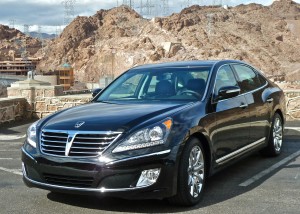
Equus gives Hyundai a competitor at $60,000 for competitive super-luxury cars costing over $100,000.
We had to split our time, however, and the Equus demanded attention. At $60,000, the Equus contends with the BMW 7-Series, Mercedes S-Class, Audi A8, Lexus LS460, and Jaguar’s top sedan, and it does it at half the price. When Genesis was introduced, sharing the new 4.6-liter dual-overhead-camshaft V8 with the Equus, that engine was selected by Ward’s as one of the top 10 engines in the auto world. Now, barely a year later, Hyundai has enlarged the 4.6 to 5.0, and installed its magical gas-direct-injection technology for even more power and better fuel economy. We drove that from the Las Vegas strip to Hoover Dam and back.
The Genesis Coupe, on the other hand, is being refined to directly take on the Ford Mustang, Chevrolet Camaro, Nissan 370Z, and the Infiniti G37 Coupe. The Genesis Coupe, which really bears no resemblance to the luxurious Genesis sedan, was introduced in 2009, improved for 2010, and again for 2011. With a new grille, restyled front end, and a whole new interior, including a sportier steering wheel, the Genesis Coupe seems a lot more extensively refined than a normal mid-cycle refresh.

Genesis Coupe adds power and expands its aim to Mustang and Camaro with both a 2.0 Turbo and a 3.8 V6..
Under the hood is where the Genesis Coupe truly comes to light. There are two engine choices, one being the 2.0-liter Turbo that can be found in the Sonata 2.0T, or the 3.8-liter Lambda V6, for those who just have to have more power. It’s interesting to scan up from the 2.4-liter four’s 200 horsepower to find the 2.0-Turbo at 274 horsepower, and the 3.8 Lambda engine now also with gas-direct-injection, hits an amazing 348 horsepower.
I suspected the Genesis Coupe might get a dose of that big 5.0 GDI V8, but only until I drove the R-Spec 3.8 V6. It doesn’t need more. At 274 horses, the Theta 2.0 Turbo is a 30-percent increase over the previous 210, and the 275 foot-pounds is 23 percent more torque than the previous Theta’s 223. It also loses nothing in fuel economy. The 21 city/30 highway EPA figures match the previous version with manual, and the new 8-speed version of the 2.0 Turbo shows 20/31, compared to the 20/30 of the old version, with a 5-speed automatic.
A refreshing approach to consumers is that if you buy the Coupe with the 2.0 Turbo, you are informed that it has 274 horsepower and 275 foot-pounds of torque with premium fuel, and if you choose to use regular gas to save a few bucks at each fill, the computerized engine module conspires to run just fine, but you’ll have to accept “only” 260 horsepower and 260 foot-pounds of torque on the lower-octane regular.
Same with the 3.8 V6. The Genesis 3.8 sedan gets by on 333 horsepower and 291 foot-pounds of torque, the Coupe’s 3.8 delivers 348 horsepower and 295 foot-pounds of torque on premium, or 344 horses and 292 foot-pounds on regular. At the diminished regular reading, of 348 horsepower at 6,400 RPMs, the Genesis Coupe has a large advantage over the 330 horsepower of the Infiniti G37 Coupe, and larger still compared to the 300 horses of the BMW 3-Series 3.0 six turbo. Both the Infiniti and BMW demand premium. The Mustang and Camaro V6es also fall short, and would need to go to the V8 to run with the Genesis Coupe.
Another asset of the Genesis Coupe is that you can select a 6-speed manual or Hyundai’s own 8-speed automatic, introduced a year ago on the renewed Genesis sedan.
After pushing both versions of the Coupe around the race track and the autocross, I was impressed with the V6’s power, without a doubt, but I actually prefered the lighter and more agile-feeling 2.0-Turbo. Pricing is most impressive, too, with the 2.0-Turbo stick at $24,250, and automatic at $25,500, while the loaded R-Spec is $34,200.
I love driving hot cars as much — or more — than most people. It is most satisfying to run such cars on race tracks, in closed-course situations. On the street, it’s ridiculous to try to extract anything other than small bursts of acceleration, which means real-world use of cars can focus on fuel economy. One of the best tests of a car’s potential remains an autocross, which is a course arranged on a large parking lot with cones designating tight turns, to examine agility and handling. Far more beneficial to real-world driving.
Hyundai pulled a fast one by flooding the autocross course with water, so that we could test the Genesis Coupe with and without stability control, and pushing too hard would result in a skid. I ran pretty well, in the upper half of the media guys in the 3.8 V6, with times of 32.590 seconds, and 32.841. I surprised myself when I got in the 2.0 Turbo, and clocked a 32.695-second run on the same course, and then reached a 31.604 that was one of the best times of the day for normal auto-journalist types. My opinion was that the lighter front end of the four made it feel a bit more balanced than the more powerful V6. If you have to accept better fuel economy with the 2.0, as gas nears $4 per gallon, most people would approve.
Comments
Tell me what you're thinking...
and oh, if you want a pic to show with your comment, go get a gravatar!


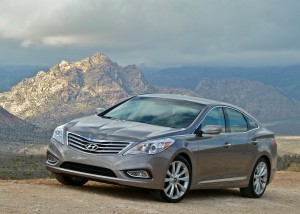
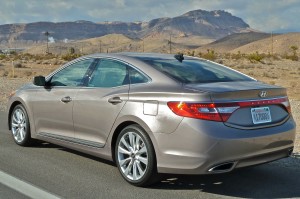
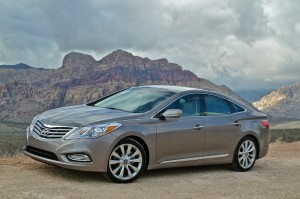
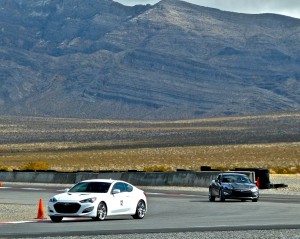
 John Gilbert is a lifetime Minnesotan and career journalist, specializing in cars and sports during and since spending 30 years at the Minneapolis Tribune, now the Star Tribune. More recently, he has continued translating the high-tech world of autos and sharing his passionate insights as a freelance writer/photographer/broadcaster. A member of the prestigious North American Car and Truck of the Year jury since 1993. John can be heard Monday-Friday from 9-11am on 610 KDAL(www.kdal610.com) on the "John Gilbert Show," and writes a column in the Duluth Reader.
John Gilbert is a lifetime Minnesotan and career journalist, specializing in cars and sports during and since spending 30 years at the Minneapolis Tribune, now the Star Tribune. More recently, he has continued translating the high-tech world of autos and sharing his passionate insights as a freelance writer/photographer/broadcaster. A member of the prestigious North American Car and Truck of the Year jury since 1993. John can be heard Monday-Friday from 9-11am on 610 KDAL(www.kdal610.com) on the "John Gilbert Show," and writes a column in the Duluth Reader.